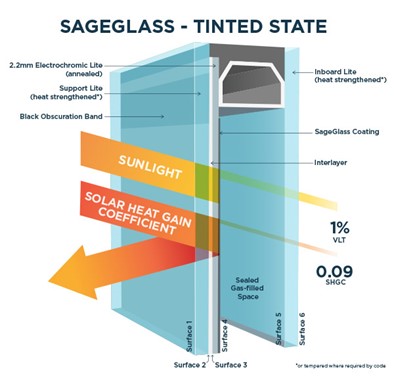USGlass Magazine & USGNN Headline News
The Info Source of record for architectural glass leaders. Facade Glass Detail

The commercial component of the Massachusetts Department of Energy Resources (DOER) updated building energy codes went into effect on July 1, 2023. The Bay State updated its stretch codes, including revisions to the base code, stretch energy code (with regulations targeting curtainwalls, window walls and storefront windows), and net zero code. Massachusetts enacted its first stretch energy code in 2010.
According to code consultant Tom Culp, the updated stretch codes aim to improve vision and spandrel glass performance. However, the rules could reduce the use of curtainwall and window areas and switch to punched openings.
“We will not be able to design all-glass buildings anymore,” Andrea Love told the Boston Society for Architecture (BSA). Love is the director of building science at Payette and president of the BSA American Institute of Architects Board of Directors. “We must look at the code first and then think about design—not the other way around. This is a shift in how we design façades.”
The Massachusetts Commercial Stretch Code and opt-in Specialized Code state specifically that vision glass used in high- and low-glazed wall system buildings must have a maximum whole assembly U factor of U-0.25. Low-glazed wall systems that are less than or equal to 50% of the total above-grade wall area of the building’s thermal envelope must comply with Equation 4-2a. High-glazed systems need to comply with Equation 4-2b.
Culp explained to attendees at the National Glass Association’s Glass Conference in late July that Massachusetts did offer an “accommodation” of U-0.30 if using thermally broken frames, triple glazing with two low-E coatings, argon, warm-edge spacers and a center-of-glass U-factor of 0.14.
However, Katie Raymond, senior engineer at Epsilon Associates, wrote in a company article that while some double-glazed glass can achieve a U-factor of 0.25, de-rating “metal framing negatively impacts the window’s insulation quality, bringing the U-factor up. This means that in practice, reaching the whole-assembly 0.25 U-factor with double-glazed windows is virtually impossible, making triple glazing a necessity.”
In response to the updated energy codes, the Home Builders and Remodelers Association of Massachusetts sponsored a study by the Massachusetts Institute of Technology and Wentworth Institute of Technology to determine their impact on affordability.
The study detailed several obstacles to building more energy-efficient structures, including apartment buildings. Among the various challenges detailed in the study include a shortage of technical assistance and skilled labor.
The researchers wrote that “As [Massachusetts] attempts to increase the energy efficiency of new construction rapidly, one issue builders face now is the lack of skilled labor trained in the increased requirements of more efficient building and Passive House certification … There are fewer opportunities for formal training for tradespeople regarding other dimensions of energy-efficient construction such as mitigating thermal bridges, or installing heat and energy recovery ventilation, vapor barriers, and energy-efficient doors, windows and siding.”
Your email address will not be published. Required fields are marked *
Save my name, email, and website in this browser for the next time I comment.

Glass Wall U Channel System We understand that ads can be annoying to website visitors but it helps us provide our content to you at no cost so we'd appreciate it if you would allow our advertising partners to appear in your browser. Thanks!